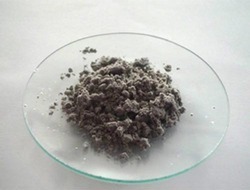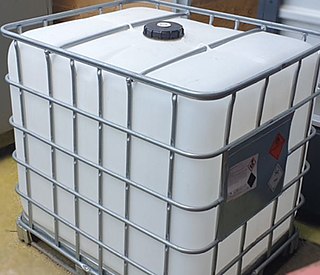Related Research Articles

A fuel cell is an electrochemical cell that converts the chemical energy of a fuel and an oxidizing agent into electricity through a pair of redox reactions. Fuel cells are different from most batteries in requiring a continuous source of fuel and oxygen to sustain the chemical reaction, whereas in a battery the chemical energy usually comes from substances that are already present in the battery. Fuel cells can produce electricity continuously for as long as fuel and oxygen are supplied.

In chemistry, a hydride is formally the anion of hydrogen (H−), a hydrogen ion with two electrons. In modern usage, this is typically only used for ionic bonds, but it is sometimes (and more frequently in the past) been applied to all compounds containing covalently bound H atoms. In this broad and potentially archaic sense, water (H2O) is a hydride of oxygen, ammonia is a hydride of nitrogen, etc. In covalent compounds, it implies hydrogen is attached to a less electronegative element. In such cases, the H centre has nucleophilic character, which contrasts with the protic character of acids. The hydride anion is very rarely observed.

A hydrogen vehicle is a vehicle that uses hydrogen to move. Hydrogen vehicles include some road vehicles, rail vehicles, space rockets, forklifts, ships and aircraft. Motive power is generated by converting the chemical energy of hydrogen to mechanical energy, either by reacting hydrogen with oxygen in a fuel cell to power electric motors or, less commonly, by hydrogen internal combustion.
Natrium is the Latin name of sodium.

Herbert Charles Brown was an American chemist and recipient of the 1979 Nobel Prize in Chemistry for his work with organoboranes.

Alternative fuels, also known as non-conventional and advanced fuels, are fuels derived from sources other than petroleum. Alternative fuels include gaseous fossil fuels like propane, natural gas, methane, and ammonia; biofuels like biodiesel, bioalcohol, and refuse-derived fuel; and other renewable fuels like hydrogen and electricity.

Sodium borohydride, also known as sodium tetrahydridoborate and sodium tetrahydroborate, is an inorganic compound with the formula NaBH4. It is a white crystalline solid, usually encountered as an aqueous basic solution. Sodium borohydride is a reducing agent that finds application in papermaking and dye industries. It is also used as a reagent in organic synthesis.

A fuel cell vehicle (FCV) or fuel cell electric vehicle (FCEV) is an electric vehicle that uses a fuel cell, sometimes in combination with a small battery or supercapacitor, to power its onboard electric motor. Fuel cells in vehicles generate electricity generally using oxygen from the air and compressed hydrogen. Most fuel cell vehicles are classified as zero-emissions vehicles. As compared with internal combustion vehicles, hydrogen vehicles centralize pollutants at the site of the hydrogen production, where hydrogen is typically derived from reformed natural gas. Transporting and storing hydrogen may also create pollutants. Fuel cells have been used in various kinds of vehicles including forklifts, especially in indoor applications where their clean emissions are important to air quality, and in space applications. Fuel cells are being developed and tested in trucks, buses, boats, ships, motorcycles and bicycles, among other kinds of vehicles.

The methanol economy is a suggested future economy in which methanol and dimethyl ether replace fossil fuels as a means of energy storage, ground transportation fuel, and raw material for synthetic hydrocarbons and their products. It offers an alternative to the proposed hydrogen economy or ethanol economy, although these concepts are not exclusive. Methanol can be produced from a variety of sources including fossil fuels as well as agricultural products and municipal waste, wood and varied biomass. It can also be made from chemical recycling of carbon dioxide.

The California Fuel Cell Partnership (CaFCP) is a public-private partnership to promote hydrogen vehicles (including cars and buses) in California. It is notable as one of the first initiatives for that purpose undertaken in the United States. The challenge is which come first, hydrogen cars or filling stations.

Ammonia borane, also called borazane, is the chemical compound with the formula H3NBH3. The colourless or white solid is the simplest molecular boron-nitrogen-hydride compound. It has attracted attention as a source of hydrogen fuel, but is otherwise primarily of academic interest.
The Dodge Intrepid ESX prototype cars are the result of the 1993 response by the Chrysler Corporation to a challenge by U.S. President Bill Clinton to produce a vehicle which was capable of meeting the demands of the modern consumer, while still achieving an unprecedented 80 miles per US gallon overall in fuel economy. The PNGV - Partnership for a New Generation of Vehicles project was aimed at The Big Three American car manufacturers.
Direct borohydride fuel cells (DBFCs) are a subcategory of alkaline fuel cells which are directly fed by sodium borohydride or potassium borohydride as a fuel and either air/oxygen or hydrogen peroxide as the oxidant. DBFCs are relatively new types of fuel cells which are currently in the developmental stage and are attractive due to their high operating potential in relation to other type of fuel cells. Recently, DBFCs that rival proton-exchange membrane fuel cells (PEMFCs) in peak power but operating at double the voltage have been reported.

The Dodge Charger R/T is a functional concept car developed in 1999 by American automobile manufacturer Chrysler. It took many styling cues from the 1960s Chargers but, unlike the original, had four doors. The designers attempted to blend the rear doors into the design so they would not be noticed very easily. The decision to add four doors was due to the declining sport coupe market in North America. Compressed natural gas was purported as being in the lineup for a possible fuel source.
Hydrogen technologies are technologies that relate to the production and use of hydrogen as a part hydrogen economy. Hydrogen technologies are applicable for many uses.

Lithium borohydride (LiBH4) is a borohydride and known in organic synthesis as a reducing agent for esters. Although less common than the related sodium borohydride, the lithium salt offers some advantages, being a stronger reducing agent and highly soluble in ethers, whilst remaining safer to handle than lithium aluminium hydride.
A water-fuelled car is an automobile that hypothetically derives its energy directly from water. Water-fuelled cars have been the subject of numerous international patents, newspaper and popular science magazine articles, local television news coverage, and websites. The claims for these devices have been found to be pseudoscience and some were found to be tied to investment frauds. These vehicles may be claimed to produce fuel from water on board with no other energy input, or may be a hybrid claiming to derive some of its energy from water in addition to a conventional source.
A methanol reformer is a device used in chemical engineering, especially in the area of fuel cell technology, which can produce pure hydrogen gas and carbon dioxide by reacting a methanol and water (steam) mixture.
The Glossary of fuel cell terms lists the definitions of many terms used within the fuel cell industry. The terms in this fuel cell glossary may be used by fuel cell industry associations, in education material and fuel cell codes and standards to name but a few.

The Jeep Treo was an electric concept car produced by Chrysler under their Jeep brand in the early twenty first century. Launched at the 2003 Tokyo Motor Show, it was envisaged for production in 2008, but the single prototype remained a one-off. Designed for the Asian young urban driver, the car was fitted with three seats and had the provision to carry mountain bikes as an integral part of the near-teardrop shaped design. Although the prototype was designed to be powered by a hydrogen fuel cell, in its production form the car was to be given hybrid petrol-electric drive.